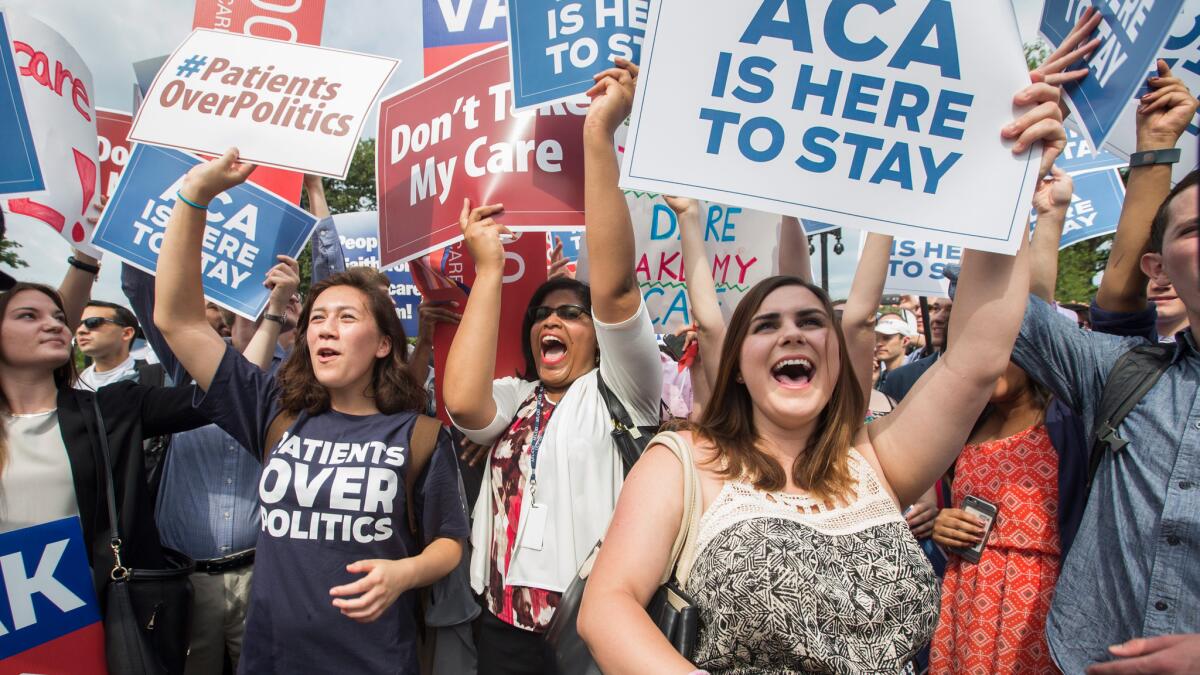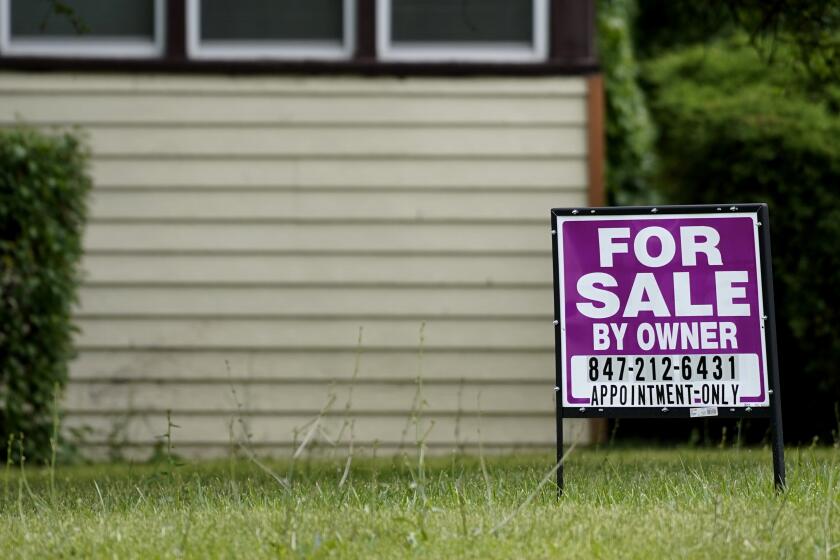Column: The truth about healthcare premiums: They’d be a lot higher without Obamacare

- Share via
We’ve just entered the “sticker shock” season of healthcare reporting: News stories are brimming with reports of double-digit premium requests from insurance companies, amid dire warnings about the impact on consumers.
Public health expert Benjamin Sommers of Harvard calls this “a new U.S. healthcare tradition: headlines about proposed premium increases under the Affordable Care Act and predictions of the law’s demise.” This year brings an additional theme — the trend’s putative effect on the presidential election. Some of the figures are certainly eye-catching — some insurers in some states are seeking increases of more than 30%. In California, where the state exchange negotiated increases of only 4.2% in 2015 and 4% this year, rates will rise by an average 13.2% next year.
But Sommers asserts that concerns over rising premiums are “overblown,” chiefly for three reasons: Most of the cited rates are initial requests, likely to be pared down by state regulators; consumers have the ability and incentive to shop for cheaper rates; and more than 80% of Affordable Care Act customers receive premium subsidies, limiting the impact of any rate increases.
In essence ... consumers received more coverage at a lower price.
— Loren Adler and Paul Ginsburg, Brookings Institution
An important new study by Loren Adler and Paul Ginsburg of the Brookings Institution adds another key factor. Their finding is that, even with an expected spike in premium increases for 2017, rates are still lower than they would have been without the Affordable Care Act. They calculate that premiums would have to rise by more than 44% for next year to approach where they would have been given the pre-ACA trend line. In fact, Adler and Ginsburg are being conservative — they calculated a rise of 5% a year from pre-ACA rates, even though the actual annual increases ranged from 11.7% in 2010 to 7-8% in 2011-2013.
The main reason for the finding is that rates dropped sharply when the ACA exchanges launched in 2014 — so much so that they still haven’t caught up to the pre-ACA trend. “That the ACA might have caused premiums to drop so precipitously when its marketplaces took effect may seem surprising at first,” Adler and Ginsburg write. “It was to us.”
Many analysts expected the ACA to drive up premiums in the individual market, though mostly because the law would improve the quality and breadth of policies. These factors included an end to exclusions or rate surcharges due to preexisting conditions and other health factors, mandates for coverage of a menu of “essential benefits,” limits on out-of-pocket costs, and the elimination of lifetime benefit caps.
Adler and Ginsburg observe that other factors were expected to deliver downward pressure on premiums, including the expansion of the customer pool by millions of persons and the introduction of competition, allowing customers to choose among several standardized plans.
“The small group market in the past was relatively small and not particularly competitive,” Ginsburg told me. Today, “in many areas, the exchanges are very competitive.” The premium subsidies make it even easier for customers to shop for plans every year, producing an incentive for insurers to maintain price-competitiveness.
The post-ACA trend in premiums has significantly outstripped expectations. Rates in 2016 came in 20% below the Congressional Budget Office’s projections in 2009, before the ACA’s passage. This reflects an overall slowing of healthcare inflation over that period. The reasons for the slowdown are imperfectly understood and may include the post-2008 economic slowdown, though the Congressional Budget Office agrees that the ACA deserves some of the credit.
Ginsburg told me that one of his goals in performing this analysis was “myth-busting, since everything is so polarized in discussions of Obamacare.” He’s gratified that the main reaction to the analysis is an effort to “get behind the data and examine what are the key factors” in premium trends.
Comparing pre-ACA individual plans with those in the post-ACA exchange market is difficult because the customer base and typical benefits are so different, Ginsburg acknowledges. But he and Adler calculated that average premiums for the benchmark silver-tier plan in 2014, the year the ACA exchanges began operating, were 10-21% lower than average individual market premiums in 2013 — and enrollees got significantly better coverage and greater benefits. Silver plans covered 17% more of the customer’s health expenses than the average pre-ACA plan, they note. “In essence, then, consumers received more coverage at a lower price.”
They estimate that the average annual individual premium in 2009 was $3,480, or $290 per month, for a plan that covered roughly 60% of health expenses. The average premium for a benchmark silver plan in 2014 was $3,800. That’s a rise of 9% over five years. Since the silver plan covers 70% of health expenses, “this premium was actually lower in nominal dollars than that in 2009,” Adler and Ginsburg say.
Nothing is simple in the U.S. healthcare market, of course, and the Brookings analysis comes with caveats. There are indications that premium increases in the 2014-2016 period were lower than they should have been. Some insurers may have treated initial rates as loss leaders to build their customer pool. Two government programs moderated the risk of underestimating expenses of a population that had been previously uninsured and was likely to be sicker than prior customers (the programs are expiring this year). Rates in 2017 may reflect insurers’ better knowledge of their real expenses.
Additionally, as Andrew Sprung observes at xpostfactoid, lower premiums are balanced out to some extent by higher deductibles and co-pays. This creates a perception problem, in addition to a financial one: Customers who are healthy benefit from low premiums, but those who are sick start incurring unexpected costs. Those who were younger and healthy in the pre-ACA era and got great rates as preferred customers may pine for those far-off days, in part because they “weren’t in among the 34% who paid above-market rates for medical reasons, or the 13% who couldn’t get coverage at all,” as Sprung notes.
Ginsburg acknowledges that 2017 may be a year of markedly higher premiums, but he doesn’t expect the spike to last, since insurers are probably trying to wring out the mismatch between premiums and expenses in one fell swoop. “I don’t think 2018 will also be a big year,” he says. “I expect a return to sustainable increases.”
Keep up to date with Michael Hiltzik. Follow @hiltzikm on Twitter, see his Facebook page, or email [email protected].
Return to Michael Hiltzik’s blog.
MORE FROM BUSINESS:
China’s LeEco buys Irvine TV maker Vizio for $2 billion
Stocks finish mixed; McDonald’s plunges and Texas Instruments jumps
U.S. new-home sales climb to more than 8-year high
More to Read
Inside the business of entertainment
The Wide Shot brings you news, analysis and insights on everything from streaming wars to production — and what it all means for the future.
You may occasionally receive promotional content from the Los Angeles Times.











